There is only one painting depicting Ludwig van Beethoven (Bonn, 1770 - Vienna, 1827) that was executed when the great German composer was still alive: it is the celebrated portrait depicting him together with the manuscript for the Missa Solemnis, the 1820 work of Joseph Karl Stieler (Mainz, 1781 - Munich, 1858), now preserved at the Beethoven-Haus in Bonn. The paucity of contemporary iconographic evidence for Beethoven, however, is not even remotely comparable to the great fortune the master enjoyed after his death: the exhibition Seeing Music. Art from Symbolism to the Avant-Garde (in Rovigo, Palazzo Roverella, from April 26 to July 4, 2021, curated by Paolo Bolpagni in collaboration with Francesco Parisi and Benedetta Saglietti) has dedicated, in its long journey to discovering the links between visual arts and music in the late 19th and early 20th centuries, a section also to the myth of Beethoven in art in the same period.
The reasons for such a fortune are well understood when one considers, Bolpagni writes, Beethoven’s stature as “a composer who embodied the culmination and contextual overcoming of Viennese classicism” and who became, “in a somewhat paradoxical way, the paradigm of the titanic and cursed musician, a misunderstood genius struggling with his time, terrible in appearance and expression, often gloomy and pensive.” A reconnaissance through the visual arts in search of suggestions that tell the myth of Beethoven is certainly not a new thing: already between the 1920s and the 1940s the links between Beethoven and Romanticism were examined by a number of scholars (Arnold Schmitz, Jean Boyer, Leo Schrade), to continue with musicologist William S. Newman who, in a 1983 essay, spoke of Beethovenian “mysticism” to refer to the atmosphere of mystery and veneration for Beethoven that soon spread through the arts that paid homage to the genius (Newman recalled that Victor Hugo called Beethoven the “mystic prophet of music”). However, examinations of the reception of the fortunes of Beethoven’s myth in Italy had been episodic, and the analysis performed by Benedetta Saglietti, a musicologist and Beethoven expert (who also authored the 2019 essay Beethoven as a Late Nineteenth-Century Pivotal Figure in the Italian Visual Arts, published in the volume Music and the Figurative Arts in the Nineteenth Century edited by Roberto Illiano), focuses mainly on the diffusion of Beethoven iconography in our country, also presenting some previously unpublished works.
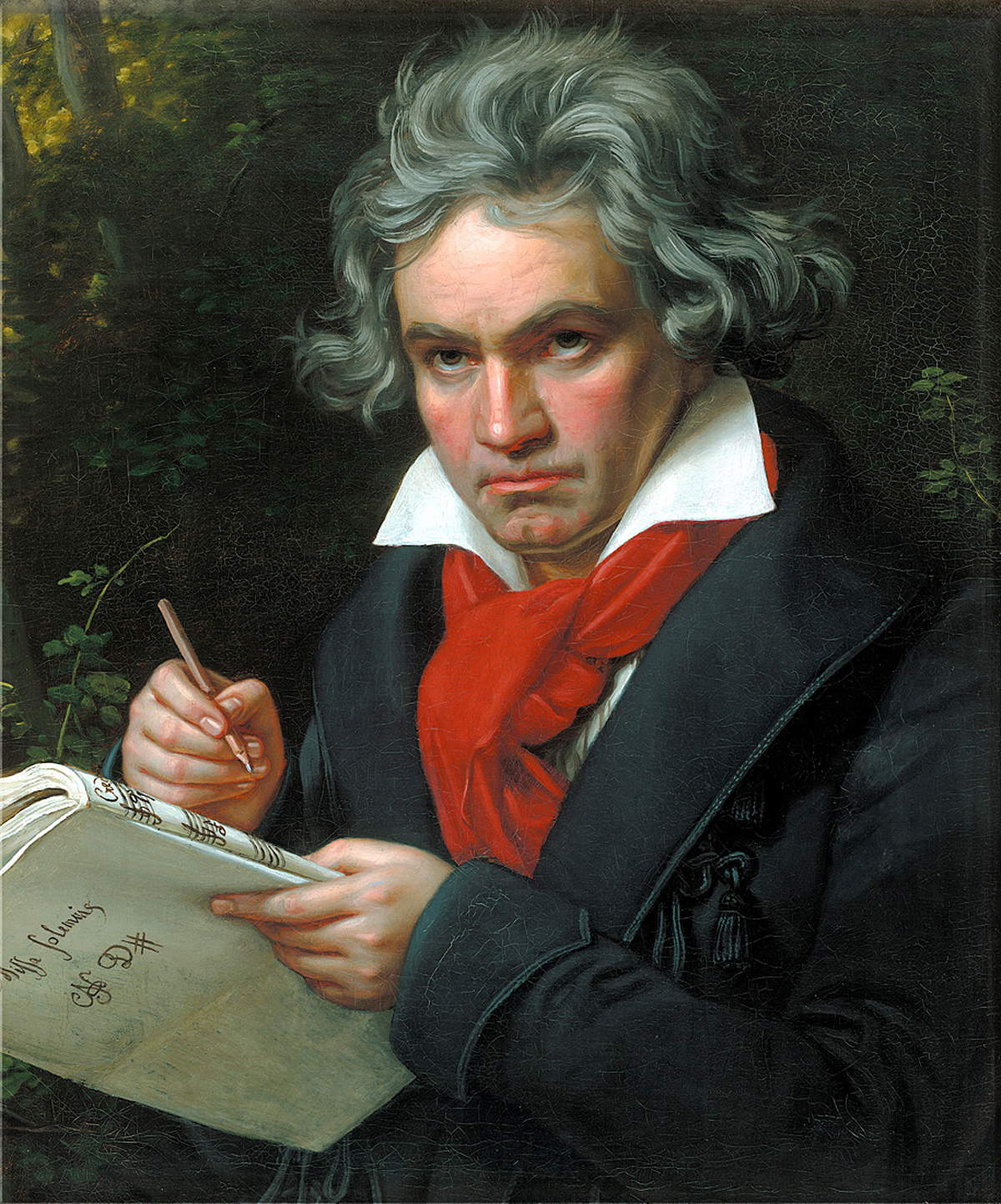 |
| Joseph Karl Stieler, Portrait of Ludwig van Beethoven (1820; oil on canvas, 62 x 50 cm; Bonn, Beethoven-Haus). Work not exhibited in Rovigo |
In Italy, the known origins of the spread of the myth are to be found between the 1860s and 1870s: in the 2019 essay, Saglietti wrote that it was from the seventh decade of the 19th century onward on the peninsula that performances, discussions and in general knowledge about Beethoven’s works (as well as his figure) began to increase. Prior to 1860 there are few Italian portraits of Beethoven, but from this decade onward depictions of the Bonn composer began to multiply, especially in the plastic arts. Among the earliest portraits it is possible to include that of Passquale Romanelli (Florence, 1812 - 1887), the first draft of which, dated 1867, is preserved in the Galleria d’Arte Moderna in Genoa: it is a singular sculpture depicting Beethoven as a young boy, a theme that was itself quite successful, since others tackled it. This is the case, for example, of Giuseppe Grandi (Ganna, 1843 - 1894), who returned to the theme in 1874 with a work that does not denote a strict adherence to Beethoven’s real physiognomy (and of which the Rovigo exhibition presented an unpublished bronze replica, preserved in a private collection): Grandi preferred to deal very freely with the subject in order to restore to the relative, even from an image that presents him as a teenager, his aura of a titanic composer. So here is the shot of the hand that becomes a metaphor for creation, the deep gaze, the tousled hair. The work was commissioned from Grandi by the Turin composer Benedetto Junck (Turin, 1852 - 1903): Grandi and his patrons, writes the scholar, “saw in Beethoven the irregular genius, the exponent of an innovative art (think especially of his last works) that, by analogy, spread the word of the scapigliati around the world.”
More studied, though seldom reproduced, is the Bust of Beethoven made around 1897 by Leonardo Bistolfi (Casale Monferrato, 1859 - La Loggia, 1933), and now preserved at the Museo Civico of Casale Monferrato, named after the same sculptor (it was, moreover, restored in 2020). It is a decidedly more traditional portrait and adheres to the effigy of Beethoven that has become fixed in the collective imagination, since Bistolfi based his images on the model of the mask that sculptor Franz Klein (Vienna, 1779 - 1840) executed in 1812 directly on the face of the composer in his lifetime (it was commissioned by the Streicher family, piano manufacturers, for a gallery of distinguished composers: Italy has a cast of it preserved at the Vittoriale degli Italiani and belonging to Gabriele d’Annunzio). Bistolfi, in his portrait of Beethoven, is notable for his attempt to give movement to the subject, by means of an almost pictorial working of the plaster, with the material being treated irregularly to create grooves, vibrations, areas that are more in relief and others that are flatter (see, for example, the hair, or even the scarf, which is modeled in an almost instinctive way, to give the impression that it has been knotted quickly and is fluttering). Instead, a youthful bronze portrait by Marcello Mascherini (Udine, 1906 - Padua, 1983) dates from 1925, among the earliest works by the Friulian artist, who in his sculpture (not exhibited in Rovigo) “achieved a balance between superhuman stiffness effectively expressed in the frowning forehead, the strong-willed jaw and the tight mouth, contrasting with the sinuosity of the hair” (thus Saglietti). Homages that sought to offer a rendering of Beethoven’s stature rather than of his features were very frequent: one of the most interesting, for example, is Beethoven, grand masque tragique performed in 1901 by �?mile-Antoine Bourdelle (Montauban, 1861 - Le Vésinet, 1929), and aimed at communicating to the viewer Beethoven’s inner torment (Bourdelle nurtured a strong passion for Beethoven and dedicated several other works to him).
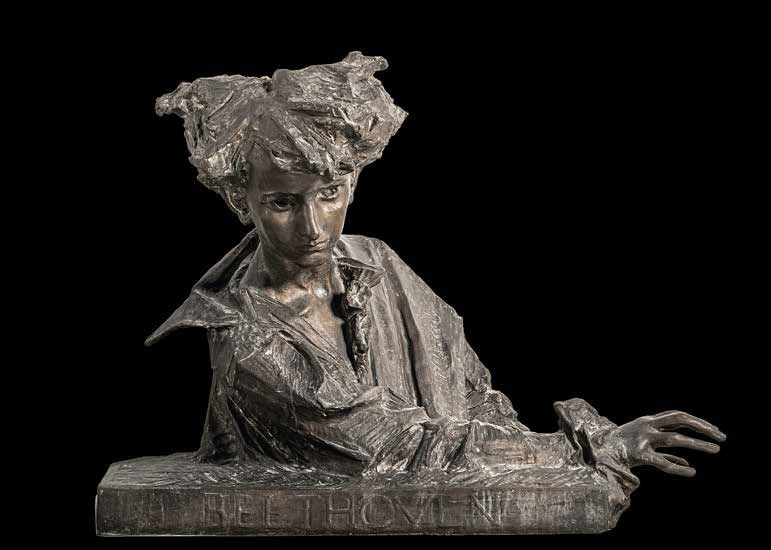 |
| Giuseppe Grandi, Beethoven as a child (Beethoven as a youth) (1874; bronze, 70 x 93 x 34 cm; Private collection) |
 |
| Leonardo Bistolfi, Bust of Beethoven (c. 1897; plaster, 58 x 40 x 40 cm; Casale Monferrato, Museo Civico e Gipsoteca Leonardo Bistolfi) |
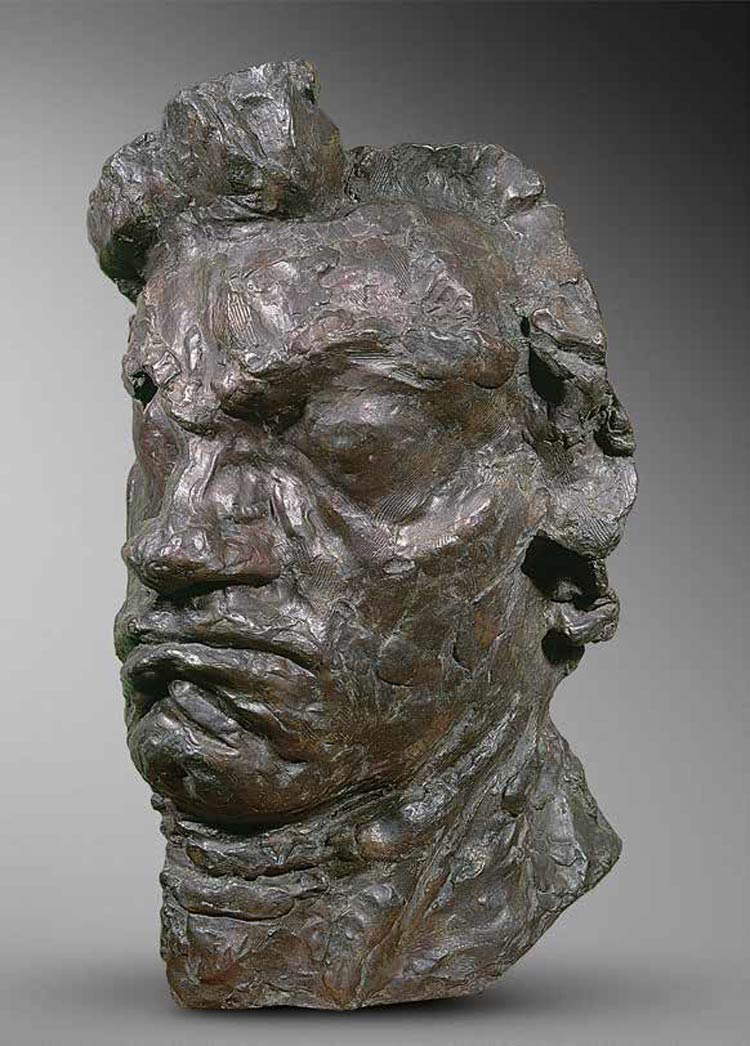 |
| �?mile-Antoine Bourdelle, Beethoven, grand masque tragique, variant (1900; bronze, 74.6 x 49 x 37 cm; Paris, Musée Bourdelle) |
In addition to portraits, the Italian reception of the figure of Beethoven is also demonstrated by works inspired by his compositions or directly by his figure. One of the earliest in this sense is Beethoven by Lionello Balestrieri (Cetona, 1872 - 1958), a painting from 1899-1900, also formerly exhibited under the title La Sonata a Kreutzer: the Tuscan artist first exhibited his canvas at the 1900 Universal Exhibition in Paris (winning a gold medal) and in 1901 took it to the Venice Biennale, where it was purchased by the Revoltella Museum in Trieste (where it is still located today). Balestrieri’s canvas was a great success, so much so that the artist was forced to make numerous replicas: the scene, a bohemian setting, takes place in an interior. On a parquet floor, a violinist is playing, with his back turned, absorbed, while on the left a series of characters (some sitting on chairs, another standing, leaning on a stool with outstretched legs, caught smoking with a lost look) are intent on listening to the music. We do not know what the violinist is playing: probably not the Kreutzer Sonata, since Balestrieri never used this title for his work (it was assigned to it by the press). Interestingly, next to the smoking figure, whom we see in a frontal position in front of the back wall, hangs the very mask of Beethoven. The violinist and journalist Giuseppe Vannicola (Montegiorgio, 1876 Capri, 1915), who is probably the violinist portrayed by Balestrieri, in his novella Sonata Patetica, has the painter Lionello Olevano (Balestrieri’s alter ego, whom Vannicola knew very well) say, noting the interplay of references between violinist and composer: “Beethoven’s mask in that inscrutable sadness materialized in plaster, hints from above the piano, at the bottom of the picture, at the two virtuosi enraptured in the hearing of the music they themselves perform.” In Balestrieri’s work, moreover, Saglietti says, there is a sense of Beethoven’s “presence-absence”: the artist is not directly depicted, but he is the “absent” protagonist of the painting as he is evoked. Something similar would later occur in a painting by Felice Casorati (Novara, 1883 - Turin, 1963) titled Beethoven, from 1928, kept at the Mart in Rovereto: here, the composer’s presence is in the score leaning on the chair to which the little girl dressed in white who is the painting’s protagonist is leaning. “An absence,” wrote art historian Giorgina Bertolino, “that is almost a cunning invitation to remember better.”
Returning to Balestrieri’s painting, the figure of Vannicola is, moreover, useful to introduce the topic of the diffusion of Beethoven portraits in the art of woodcut: Vannicola’s work entitled De profundis clamavi ad te, a mystical book dedicated to the violinist’s companion, Olga de Lichnizki, in the La Revue du Nord edition features a portrait of Beethoven on its cover (his music is, in fact, the guide to the initiatory journey the author takes the book’s readers on). It is a work by Giovanni Costetti (Reggio Emilia, 1874 - Settignano, 1949), to whom we also owe the other illustrations in De profundis clamavi ad te: in one of them, particularly original, dense with Symbolist cues, Beethoven is depicted in profile, immersed in a wave that merges with his hair. For Benedetta Saglietti, the Reggio Emilia engraver wanted to give substance to the anthroposophical thought according to which the artist may be able to give form to the vibrations that spring from the brain of genius.
Also in the Italian sphere are instances of works that refer directly to Beethoven’s compositions, such as the engraving by Dario Neri (Murlo, 1895 - Milan, 1958) from about 1927 entitled Marcia funebre in morte d’un eroe, on the theme of theEroica (or, Saglietti speculates, more likely the Piano Sonata Op. 26): Neri attempts to provide an evocative visual correspondent of Beethoven’s music by drawing a procession composed of four men celebrating the hero’s funeral (whose spirit is symbolized by the red waves that his body exhales, which could, however, also allude to the fire of the funeral pyre) by carrying him on their shoulders to the top of a sort of ziggurat. Gaetano Previati (Ferrara, 1852 - Lavagna, 1920), whose great passion for music is well known, was also captivated by the charm of theEroica, dedicating to this composition a triptych of the same name now preserved at the headquarters of the Associazione Nazionale fra Mutilati e Invalidi di Guerra, and characterized by the fiery red with violet hues that dominates the entire composition where we see the hero fighting, succumbing and finally burning on the pyre. In contrast, the 1908 work painted for the Music Room of Vittore Grubicy’s house (and now at the Vittoriale instead) inspired by the Pastorale is of a different tenor: here, a dance of engorged youths evokes the music of Beethoven’s Sixth Symphony. Both of Previati’s works, though not in the Rovigo exhibition, are mentioned in the catalog. The famous Moonlight, on the other hand, is featured in a 1903 illustration by Filiberto Minozzi (Verona, 1877 - Milan, 1936), which well communicates the muffled atmosphere of Beethoven’s sonata with a work that reveals affinities with certain Previati solutions.
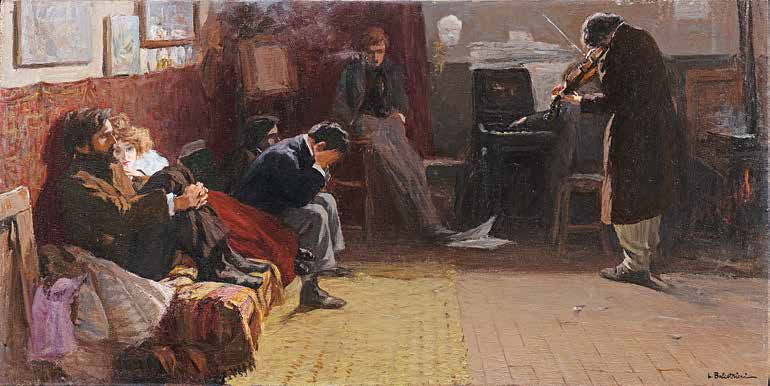 |
| Lionello Balestrieri, Beethoven (1900; oil on canvas, 43 x 90 cm; Turin, GAM, Galleria Civica dArte Moderna e Contemporanea) |
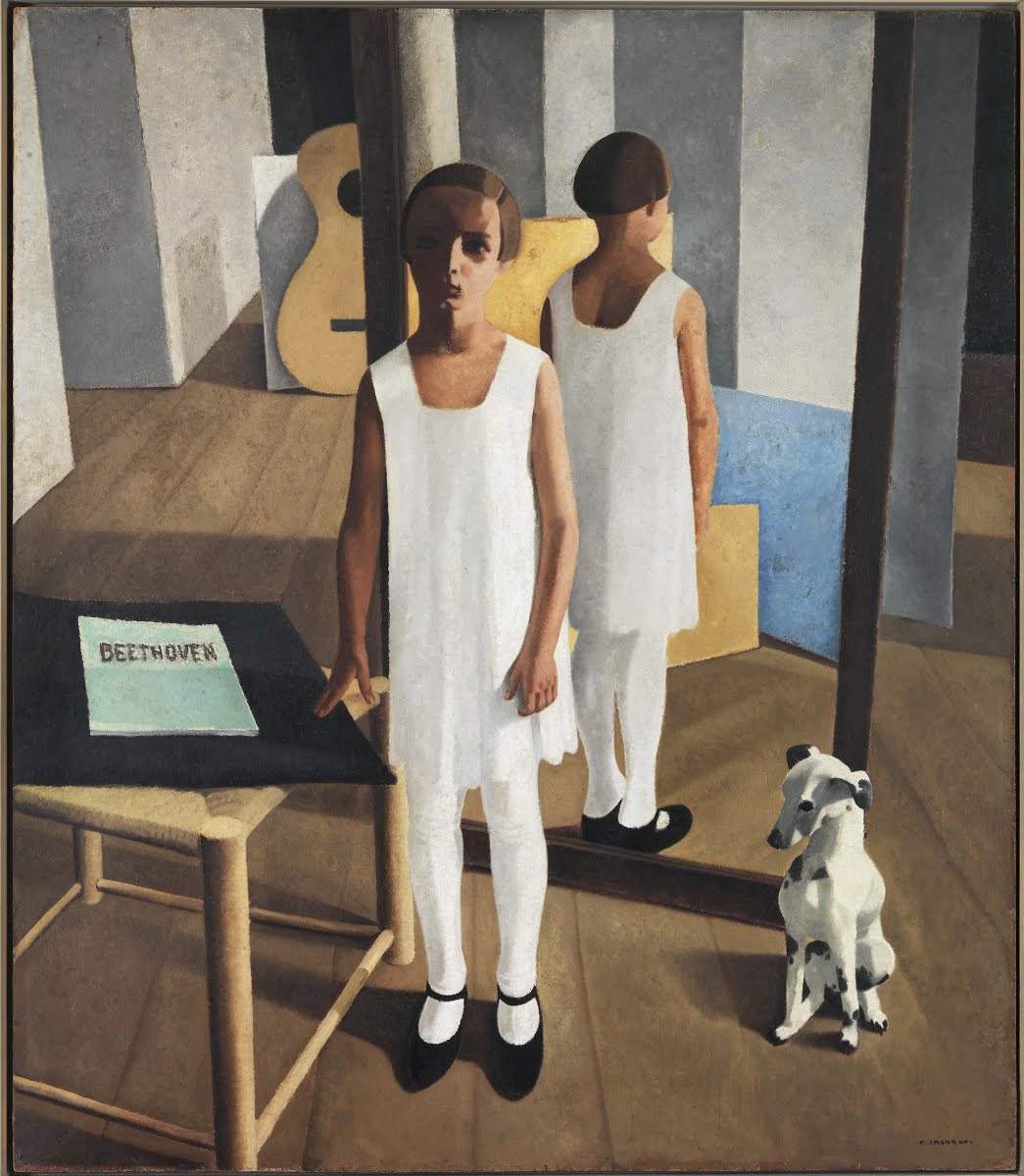 |
| Felice Casorati, Beethoven (1928; oil on panel, 139 x 120 cm; Rovereto, Mart, Museo di arte moderna e contemporanea di Trento e Rovereto, VAF-Stiftung Collection) |
 |
| Giuseppe Vannicola, De profundis clamavi ad te, �?dition de la Revue du Nord, Rome (1906; book title page, letterpress, 25 x 18.5 cm; Milan, Libreria antiquaria Pontremoli) |
![Giovanni Costetti, [Ludwig van Beethoven] (1905 circa, in Giuseppe Vannicola, De profundis clamavi ad te, �?dition de la Revue du Nord, Firenze 1905, p. [34], libro, stampa tipografica, 84 x 75 mm; Roma, Collezione F.P.)
Giovanni Costetti, [Ludwig van Beethoven] (1905 circa, in Giuseppe Vannicola, De profundis clamavi ad te, �?dition de la Revue du Nord, Firenze 1905, p. [34], libro, stampa tipografica, 84 x 75 mm; Roma, Collezione F.P.)](https://cdn.finestresullarte.info/rivista/immagini/2021/1652/giovanni-costetti-beethoven.jpg
) |
| Giovanni Costetti, [Ludwig van Beethoven] (c. 1905, in Giuseppe Vannicola, De profundis clamavi ad te, �?dition de la Revue du Nord, Florence 1905, p. [34], book, letterpress, 84 x 75 mm; Rome, F.P. Collection) |
 |
| Gaetano Previati, L’eroica (1907; oil on canvas; Rome, Casa Madre Associazione Nazionale fra Mutilati e Invalidi di Guerra). Work not exhibited in Rovigo |
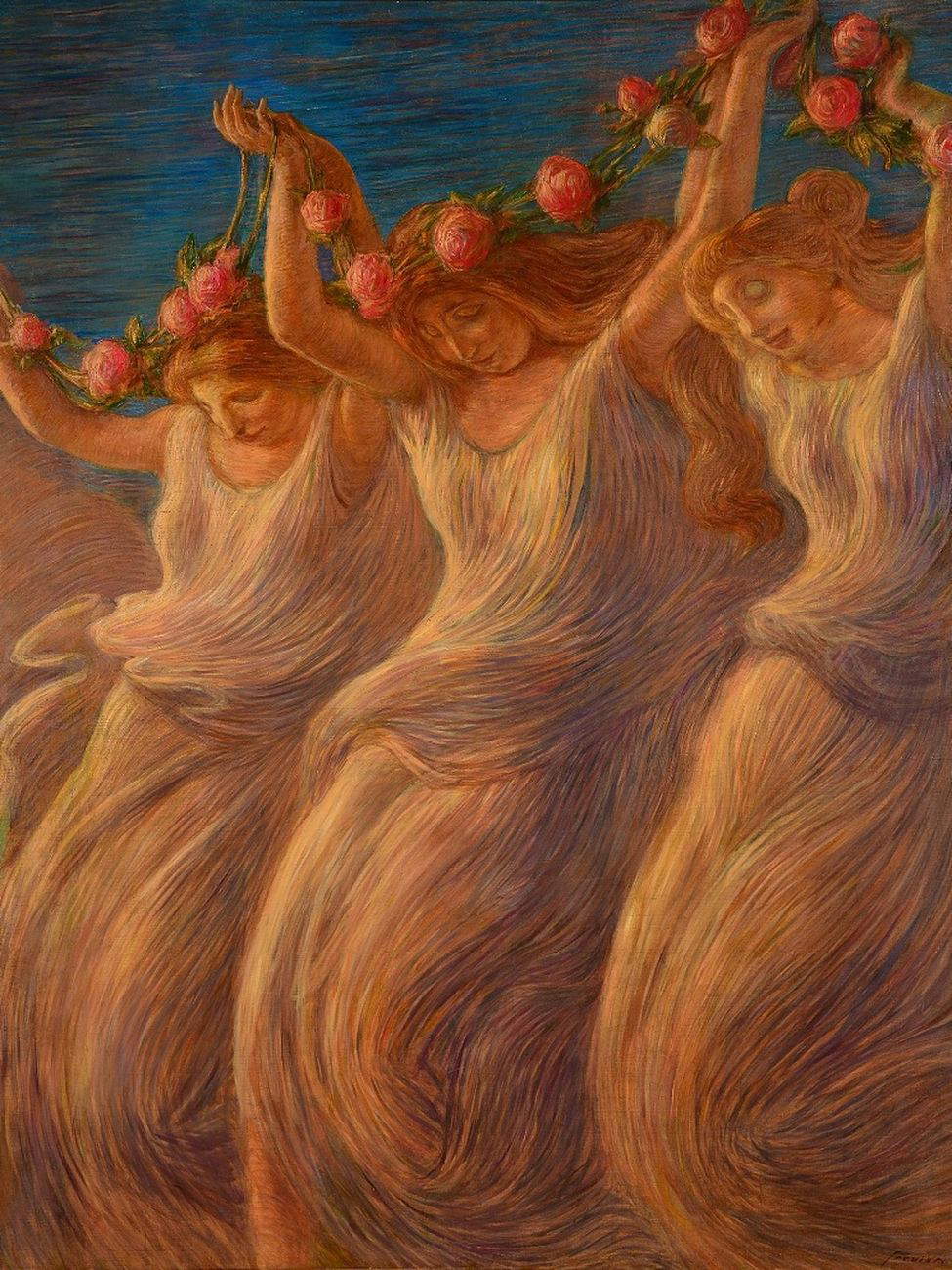 |
| Gaetano Previati, The Dance (Pastorale) (1908; oil on canvas, 165 x 201 cm; Gardone Riviera, Vittoriale degli Italiani). Work not exhibited in Rovigo |
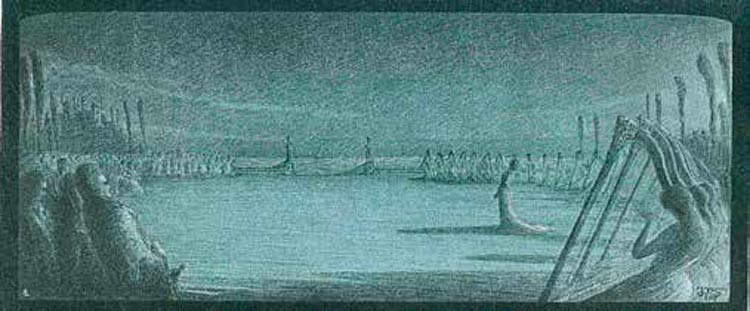 |
| Filiberto Minozzi, Beethoven - Clair de lune, from Pictorial Impressions from Famous Musical Compositions, in Novissima. Rivista dArti e Lettere, 3, Milan (1903; Milan, Libreria antiquaria Pontremoli). Work not exhibited in Rovigo |
In Germany and Austria, lands where Beethoven’s music was widely circulated, artistic tributes were present but discontinuous: the first monument in his hometown, however, was erected as early as 1845, in Münsterplatz. It is the statue of Ernst Julius Hähnel (Dresden, 1811 - 1891) still visible in the square today. But beyond monuments (one was made in Italy as well: the one by Francesco Jerace exhibited at the Venice Biennale in 1895 and then placed in the cloister of the Conservatorio San Pietro a Majella in 1925), Beethoven’s fortunes were not slow to manifest themselves through other forms of expression as well. In the German area, one of Beethoven’s most heartfelt admirers was Alois Kolb (Vienna, 1875 - Leipzig, 1942), author, in 1909, of an etching entitled Diesen Küss der ganzen Welt (“This Kiss to the Whole World”), a portrait of Beethoven, depicted with his eyes closed with his usual frown reworking the connotations of the 2012 mask, with the figures of two naked lovers kissing on his head. The title of the work refers to the famous line from theOde to Joy, the poem by Friedrich Schiller set to music by Beethoven in 1793 (the Ninth Symphony): the two kissing figures are meant to convey the vitalism of Beethoven’s music. Kolb was also the author of a series of ten engravings inspired by Beethoven’s works: these are works with which the Austrian artist tried to create allegories to translate Beethoven’s symphonies into images (for example, in the print dedicated to the Ninth Symphony, Kolb translates the embrace of the multitudes, Millionen in the German text, with the depiction of an ethereal and festive crowd).
The same purpose animated another engraver, Arthur Paunzen (Vienna, 1890 - Douglas, 1940), who in 1918 executed a cycle of etchings titled Phantasien über Beethovensymphonien (“Fantasies on Beethoven’s Symphonies”), which offer an “intimist and tragic reading of some of the symphonies, in a different direction than Alois Kolb,” Saglietti writes. “Paunzen,” the scholar explains, "imagined a Ninth Symphony ordering the multitudes into a kind of Tower of Babel, while the tremendous, ominous hand of fate in the Fifth Symphony knocked above a Gothic cathedral dissolving in smoke or dark fog, oppressing a throng of initiates climbing a steep staircase. The third movement of the Pastoral, according to the score’s indentation (’Merry gathering of country people’), took in Paunzen the guise of a group of peasants, stylized into small white silhouettes against a desolate background." Motifs frequented by other artists also return, such as the procession for the Funeral March of theEroica, a symphony to which Paunzen also dedicates another work, which depicts a naked warrior playing the charge with a trumpet.
 |
| Alois Kolb, Diesen Ku�? der ganzen Welt (c. 1909; etching and aquatint, 425 x 425 mm; Emanuele Bardazzi Collection) |
With regard to works from the German area, it is then worth mentioning the exhibition that the Vienna Secession dedicated in 1902 to Beethoven himself. At least two works are worth mentioning: the celebrated Beethovenfries (“Beethoven Frieze”) by Gustav Klimt (Vienna, 1862 - 1918) and the Beethoven by Max Klinger (Leipzig, 1857 - Gro�?jena, 1920). The Beethoven Frieze is a monumental work that Klimt developed over a length of 24 meters, and is now preserved in the Vienna Secession Palace. The work is entirely inspired by the Ninth Symphony and is divided into three walls, corresponding to the three sections that also make up the work iconographically: the first depicts the yearning for happiness, the second depicts suffering humanity and hostile forces, and the third depicts the arts and the chorus of angels. The protagonist of the frieze is a knight (who has the likeness of Gustav Mahler, a friend of Klimt’s) harnessed in golden armor, moved by the entreaties of two naked women and two other figures, also naked, a man and a woman, who kneel before him to invite him to fulfill his path. The horseman is the artist’s allegory. The central wall is the one that depicts suffering humanity and hostile forces, the latter represented by the giant Typhoeus (a monstrous being with the appearance of a huge ape with the body of a snake) and his daughters, the monstrous gorgons (who precisely because of their appearance were despised by critics), personifications of the evil found in the world. It is only through art and love (third wall) that evil can be defeated: hence the final kiss between two naked figures (the man is the knight-artist who through the power of art overcame adversity, and the kiss alludes to the verse Diesen Küss der ganzen Welt) and the accompanying chorus of angels sanction the triumph of the hero, art, and love (an earthly, carnal love) over fear and bestiality.
The large monument that Klinger dedicated to Beethoven depicted the composer still emphatically, naked as a classical hero, in white marble, and seated on a bronze throne (one of the most interesting features of this work of Klinger’s is precisely the use of different materials), like a Greek god, in turn erected over a rocky base. Allusions to Beethoven’s divine stature are also evident in the presence of theeagle, the sacred animal of Jupiter, which almost seems to want to converse with the composer. “The complex and multi-layered deification of Beethoven,” Saglietti writes, “took place according to the criteria of the total work of art (Gesamtkunstwerk) that the lavish sculpture, born after a gestation of seventeen years, implied: the critics of the time were divided between passionate praise (especially of artists, such as Rodin, for example) and fierce critiques in the satirical press.” One such criticism is recalled by scholar Francesco Parisi in his essay on the Rovigo exhibition: critic Ludwig Hevesi regarded the statue as a jumble of objects piled up as “in einem sudafrikanischen Konzentrationlage.” Intervening to defend Klinger was his collector Harry von Kessler, who argued that Klinger had a “gedanklich” (mental, abstract, conceptual) idea of Beethoven, and therefore his Gesamtkunstwerk was best suited to communicate it.
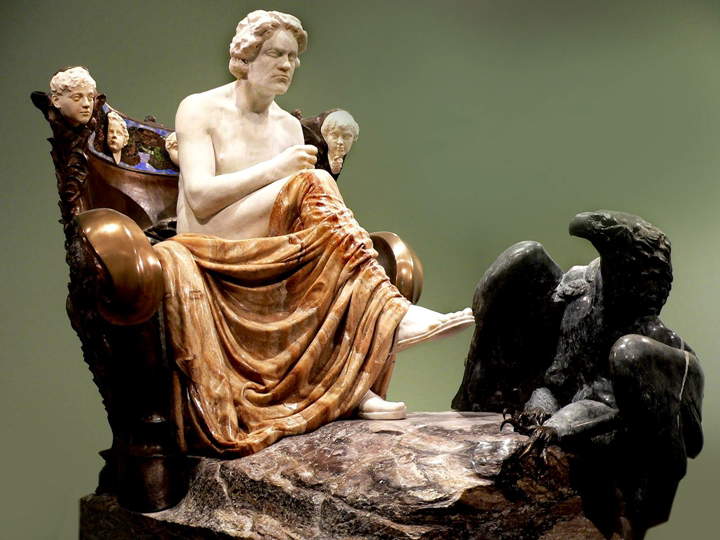 |
| Max Klinger, Monument to Beethoven (1902; various materials, height 310 cm; Leipzig, Museum der bildenden Künste). Work not exhibited in Rovigo |
 |
| Klimt’s Beethovenfries. |
 |
| Fidus, Entwurf für einen Beethoven-Tempel (1903; Bonn, Beethoven-Haus) |
Finally deserving a mention in this essential roundup is Fidus ’s (Hugo Höppener; Lübeck, 1868 - Woltersdorf, 1948) tribute to Beethoven: the artist dreamed of dedicating a temple to the composer, a project that never materialized as it was too ambitious for Fidus’s possibilities. Höppener had envisioned, in 1911-1912, a circular building crowned by a dome, which would house a monumental sculpture of Beethoven. Fidus had also begun work on the design of this sculpture: we are left with evidence of this in a work where the composer, depicted according to the most common image, is greeted, probably worshipped, by a naked woman, a probable allegory of thesoul.
A particularly varied panorama, then, which was already established a few years after Ludwig van Beethoven’s death, and which would then continue throughout the twentieth century, albeit less in the visual arts and more through new means of expression (cinema, above all: one need only recall Stanley Kubrick’s A Clockwork Orange, where Beethoven’s music plays a key role). What is certain is that from the year of Beethoven’s passing, “his work and his spirit will seem more alive than ever,” says Saglietti. “The multi-layered process of myth-making happens in different ways: depending on the historical epochs and cultures of departure and arrival, when new eyes look at it and new ears listen to it, and, finally, at the moment when the needs of individuals or a group of people are projected onto the composer. Death is a threshold, quickly crossed which Beethoven was guaranteed limmortality.”
Warning: the translation into English of the original Italian article was created using automatic tools. We undertake to review all articles, but we do not guarantee the total absence of inaccuracies in the translation due to the program. You can find the original by clicking on the ITA button. If you find any mistake,please contact us.